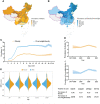Nationwide Trends of Pediatric Obesity and BMI z-Score From 2017-2021 in China: Comparable Findings From Real-World Mobile- and Hospital-Based Data
- PMID: 35721754
- PMCID: PMC9204322
- DOI: 10.3389/fendo.2022.859245
Nationwide Trends of Pediatric Obesity and BMI z-Score From 2017-2021 in China: Comparable Findings From Real-World Mobile- and Hospital-Based Data
Abstract
Introduction: Lifestyle changes including COVID-19 lockdown cause weight gain and may change obesity trends; however, timely changes are largely unknown and monitoring measures are usually lack. This first large-scale study aimed to analyze the real-world national trends of obesity prevalence of Chinese children in the past five years, and the impact of COVID-19 pandemic on pediatric obesity development through both mobile- and hospital-based data.
Methods: This study included children aged 3 to 19 years old all over China from January 2017 to April 2021. Hospital-measured and parent-reported cases from XIGAO database were analyzed. Body mass index (BMI) z-score calculation and obesity status evaluation were made according to Chinese standards. We evaluated obesity/overweight prevalence over the past five years and the changes of BMI z-score during COVID-19 lockdown.
Results: A total of 656396 children from 31 provinces were involved, including 447481 hospital-measured cases and 208915 parent-reported cases. The obesity and overweight prevalence were 8.05% (95%CI 7.76%-8.39%) and 10.06% (95%CI 10.79%-11.55%), comparable to those of China National Nutrition Surveys during 2015-2019. Northern China had the highest obesity prevalence. Parent-reported data had higher obesity/overweight prevalence than hospital-measured data (18.3% [95%CI 17.7%-18.9%] vs. 21.7% [95%CI 20.7%-23.0%]). The trend of obesity prevalence remained stable with slight decrease, but COVID-19 lockdown caused a significant increase of 1.86% in 2020. Both mobile- and hospital-based data showed weight gain in the first half of 2020. High BMI z-score increase were found among primary and junior middle school children, and children in northeast area during lockdown.
Conclusion: Weight gain during COVID-19 among Chinese children had regional differences and mainly affect primary and junior middle school children, thus warrants targeted interventions. The mobile growth assessment based on parent-reported data was a feasible, efficient and timely way for obesity monitoring among Chinese children, especially during epidemic.
Keywords: China; adolescent; body mass index; children; pediatric obesity.
Copyright © 2022 Yang, Zhang, Yu, Pei, Sun, He, Qian, Luo, Zhang and Xu.
Conflict of interest statement
Authors MZ and SZ were employed by Shijiazhuang Xigao Technology Co. Ltd. The remaining authors declare that the research was conducted in the absence of any commercial or financial relationships that could be construed as a potential conflict of interest.
Figures



References
-
- Bentham J, Di Cesare M, Bilano V, Bixby H, Zhou B, Stevens GA, et al. . Worldwide Trends in Body-Mass Index, Underweight, Overweight, and Obesity From 1975 to 2016: A Pooled Analysis of 2416 Population-Based Measurement Studies in 128·9 Million Children, Adolescents, and Adults. Lancet (2017) 390:2627–42. doi: 10.1016/S0140-6736(17)32129-3 - DOI - PMC - PubMed
Publication types
MeSH terms
LinkOut - more resources
Full Text Sources
Medical
Miscellaneous

